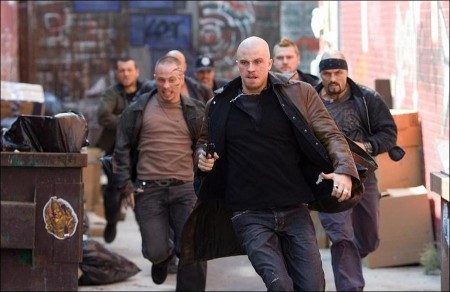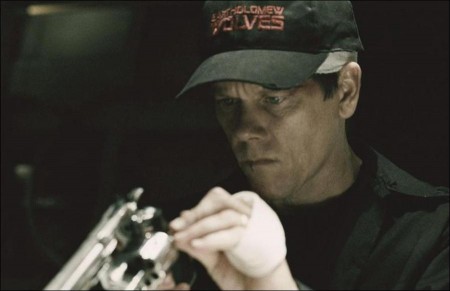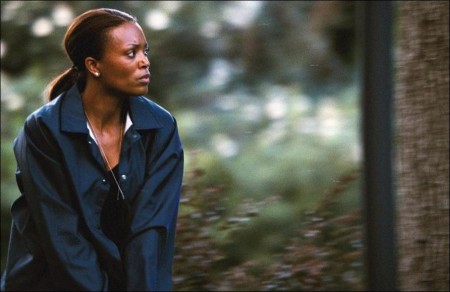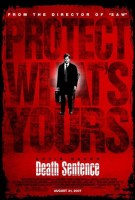Tagline: Protect what’s yours.
Nick Hume (Kevin Bacon) is an Everyman with a stable, comfortable life. He goes to work every day at his middle-management job at an insurance company. He goes home every night to his beautiful wife, Helen (Kelly Preston), and his two teenage sons, Brendan (Stuart Lafferty) and Lucas (Jordan Garrett).
The Humes are a middle-class family who are the epitome of suburban bliss. And Nick is content. He pitches in with chores around the house. He relishes the intimacy he shares with Helen. She is his confidant and equal. And he is very involved in his boys’ lives. Brendan, the eldest son, is confident and headstrong. He is popular, he is an athlete and he is on his way to college to begin a promising life of his own. Lucas looks up to his brother, but is cognizant of the shadow Brendan casts.
Lucas still hasn’t found himself, and he feels a little left out because of the adoration given to Brendan. All in all, the Humes are a typical all-American family – morally upright and humble. And then one day, their perfect life comes to a screeching halt. One night when Nick is driving Brendan home from a hockey game, he stops for gas.
While he is filling up the tank on the family car, Brendan goes inside to get a drink. Moments later, a gang of thugs enter the store in ski masks, armed with various weapons. But it is not your typical convenience store robbery: this is a rite of passage for Joe Darley (Matthew O’Leary), the younger brother of Billy Darley (Garrett Hedlund), the ruthless street leader of the gang. After terrorizing and killing the store clerk, they turn their attention to Brendan.
It is at that moment when Nick turns from the pump and looks inside the store, only to witness Joe deliver the fateful blow that ends all of the promise of Brendan’s future, and leaves him lying in a pool of blood as the gang begins to flee. But when Nick runs to help his son, he clashes with Joe and they fall to the ground. Joe is unmasked, and his own future marked.
Joe is arrested, but despite assurances from the lead investigator, Detective Wallis (Aisha Tyler), the system ultimately fails the Humes and Joe is put back on the street. Driven by a heightened sense of justice and keen grief, Nick takes matters into his own hands by seeking out his son’s killer. In his confrontation with Joe, Nick finds himself at the mercy of his emotions and ultimately kills him.
Unsure what to do, Nick runs back to the life that has always been his shelter: his wife, his surviving son and his job. Nick thinks that all is at an end – an imperfect resolution to a horrible tragedy, but fitting. Except there is blood, now, on Nick’s hands and it will not come off … Billy Darley is on the prowl, and the stage is set for a violent exchange that only escalates with each pounding beat of their hearts. How far will Nick go to protect his family? How far will Billy go to protect his own?
Bang, Bang, You’re Dead…
In one heartbeat, in one terrifying blink of the eye, the unthinkable happens and a family is altered forever.
“The story of this film is very Shakespearean,” says Director James Wan. “The theme of revenge is timeless. It’s one of our most primal emotions to want to seek vengeance when you’re done wrong. All I’m doing with DEATH SENTENCE is taking a classic story and giving it a contemporary setting.”
Executive Producer Andrew Sugerman agrees, “It is a kind of classical Greek tragedy. It’s a story about a man wrestling with his own inner demons and, because of the attachments he has to his family, he is pulled into a pattern of constant retribution that pulls his life apart. And he ultimately finds the meaninglessness of violence.”
The idea of retaliation against one’s enemies may seem like a natural course of justice. In fact, the proverb “An eye for an eye, a tooth for a tooth” (Exodus 21:23-27) has long been codified as a law of retaliation. But when it is deployed, revenge is an action that does more harm than the wrong it is intent on correcting.
“In the heat of passion, Nick Hume goes after these guys that killed his son, and he ends up opening Pandora’s Box,” Wan explains.
“It’s also about what happens to somebody when a perfectly normal life is disrupted by a senseless act that they have absolutely no control over,” adds Sugerman.
Producer Ashok Amritraj agrees, “It is a very timely movie about family and a normal life that gets torn apart. It is telling of our times because the gang violence aspect is so relevant – innocent people are caught in the middle, and you see a guy taking power into his own hands. He goes from an ordinary man, a family man, to a guy who’s on a mission.”
“It’s different than your straight up good-guy-gets-the-bad-guys flick,” says Kevin Bacon.
“There’s a horrible price that my character has to pay because he makes this choice to take the law into his own hands in order to protect and defend his family. There’s this strange moment when he thinks that maybe it has concluded, that it has been an eye for an eye and that he is now cleansed – that they’re going to be able to go on with their lives. But the fact is, you can’t wash that blood off your hands. That blood is there it comes back to haunt him.”
It’s all fun and games, until somebody gets hurt…
As it turns out, Hume is messing with the wrong people. “My character’s name is Billy Darley,” Garrett Hedlund explains, “and he’s the leader of a group of guys that grew up on the same street together. They’re in this lifestyle that chose them instead of them choosing it. Billy’s father is a guy named Bones [played by John Goodman] who is a hard as nails kind of gunslinger. I work for him, and my guys work for me.”
“He’s a criminal mastermind,” Goodman says about Bones. “He’s got his two kids working for him selling speed and coke on his corners. And Bones sells guns. He’s just a real bad guy. He’s like Fagin in Oliver Twist.”
“DEATH SENTENCE has a strong jugular because everything is about family,” remarks Hedlund. “It’s a story about two guys, where you see what happens when somebody gets too close to their family and takes one of them away.” In that regard, the two opposing relationships in the film, Nick Hume and Billy Darley, are in fact both after the same thing: to avenge their families.
Hedlund goes on to explain what makes DEATH SENTENCE different, “The guy that’s just your everyday sort of businessman reacts in a complete, maniac sort of fashion – more like you would think the guy on the whole other side of the pole would react.”
Like rams defending their turf, Hume and Darley butt heads in violent fashion. The more Hume pushes Billy Darley, the angrier Darley becomes … in large part fueled by jealousy over what Hume represents: the kind of family Billy craves and will never have.
“Bones talks down to Billy all the time,” Hedlund says. “Everything’s an argument from the moment he walks into the place, and there’s a point where he can’t take it anymore and goes crazy. He becomes psychotic with anger.”
Goodman explains Bones’ frustration, too. “He hates everything. He hates his kids; he hates the world. And there’s also this class thing. Bones is the king of his own little world, but his own little world is a pile of crap. He’s the King of Nothing.”
But as heady as the themes of vengeance, jealousy and defense may be, the ride we take with James Wan and his troupe is an exhilarating one.
“Stylistically, there’s an element to the gang that feels like a western,” Bacon states. “The last chapter of the film has an OK Corral kind of vibe. The difference, though, is that for the first part of the film Nick Hume is not a traditionally heroic character. He doesn’t start out as a bad ass, he transforms into that throughout the course of the film.”
Stick ‘em up…
And if there is a gunslinger and a posse of bandits, there’s got to be a sheriff in charge of the town. In this film, that would be Detective Wallis, played by Aisha Tyler. Wallis is the tough-on-crime, no nonsense law enforcement officer initially assigned to investigate Brendan Hume’s murder and bring Joe Darley to justice. She believes in the system, but also recognizes its limitations.
For that reason, when the routine Hume case takes an unexpected turn, Wallis finds herself torn between her duty to prevent the violence, protect both parties from harm and her desire to see justice meted out. Ultimately, she always returns to the center, condemning both criminal and victim, because at the end of the day no one is innocent in DEATH SENTENCE.
Bacon explains Tyler’s character, “She’s playing a cop who is very sympathetic to what’s happened to my character. But when she begins to realize that I’m actually responsible for some of the continuing violence that goes on, she basically says, ‘Listen, I should just put you in jail. Regardless of what happened to your family, you’re making things worse.’ So there’s this fine line that she has to walk between being sympathetic, but also wanting to lash out at me for taking the law into my own hands.”
“She’s Nick’s only connection to reality,” Tyler says. “She’s his last grounding force, his last friend. She’s also the voice of reason, the Greek chorus, the one neutral in the storm of violence. She is the character whose very presence proclaims, ‘Everybody loses in a war. There’s no winner.’ But she’s an outsider looking in.”
“It’s a class war,” Goodman states matter-of-factly. “There are no winners.”
“But at the same time, Detective Wallis isn’t jaded … in the face of everything that is going on. She has a very sophisticated understanding of the relationship between the underclass and the suburbs. She knows that the kids in the gang weren’t always the people they are now,” Tyler adds.
The inspiration
The original Death Sentence novel by Brian Garfield (sequel to his novel Death Wish) is the genesis for DEATH SENTENCE the movie, but in order to update the story of the protagonist’s continuing saga, screenwriter Ian Mackenzie Jeffers adapted the core of the story to our contemporary world where guns are readily available, drug dealing has become highly organized, the internet and cell phones provide instant communication, an as a society we have become desensitized to brutality through adrenaline-pumping action films, TV shows, music videos and video games.
“I’m a big fan of the classic revenge films of the 70’s and early 80’s,” James Wan admits. “I’ve always kept an eye out for a movie in the vein of Rolling Thunder, Death Wish, and even Mad Max. So when this project came across my desk, I went for it.”
The distinctive look of the film is also an homage to the gritty, character-driven crime films of the 70’s. Julie Berghoff has worked as Production Designer with Wan on both of his previous directorial efforts, Saw and Dead Silence.
“We love grit,” Berghoff confesses. Both James and I have a theatrical approach to design, pushing it into a hyper-reality. It’s our intention to transport the audience to the same dark and unsettling world that the characters are experiencing through the production design. We wanted the gang to be tough but have a mysterious edge. Everything is interconnected. Like the tribal art used throughout on the actors, the sets, the cars and the wardrobe. It’s very beautiful, curling itself around the limbs of characters and the bodies of the cars, like vines around everything, squeezing the life out.”
Cinematographer John Leonetti also contributed significantly to the look and style of the film. “We’ve managed to mix the 70’s into today’s technology with lighting and camera movement. When I look at the cut footage, I think of The French Connection, although DEATH SENTENCE has its own ‘vibration’ that keeps you on the edge of your seat,” Leonetti explains.
Don’t pass the buck, pass the camera…
“James told me he wanted to have one of the greatest foot chases ever put to film,” actor Leigh Whannell says smiling. “And I think he’s done it.”
One of the most dramatic sequences in DEATH SENTENCE occurs when Nick Hume is chased down on the city streets in broad daylight by the Darley gang. It was a complicated sequence to shoot that took a lot of planning and a lot more faith … Wan wanted to do something that hadn’t been done before. He wanted to shoot the three-minute plus climax of the foot chase, which takes place in a fivestory parking structure, in a single take.
“The whole chase leading up to the garage is fast and frenetic,” Wan explains. “But when you get to the parking structure, it becomes a kind of choreography.
“You follow Nick Hume running in the garage, setting off car alarms to throw the bad guys off his trail. He moves up through the levels and the camera follows him all the way, then it travels over the edge of the structure and drops all the way down to see the bad guys, then it flies back all the way up to the top. We utilized every crew member we could to shoot that shot. It’s a relay cam … one camera guy passes the camera to another for part of the sequence who then passes it to another and so on until the shot culminates with Hume having run out of room to run.”
Leonetti illustrates the complexities of the shot. “From the beginning of prep, James said how he had this shot in his head. When he showed me the garage and explained his hopes, I thought it was very cool and my instincts told me we could pull it off.
“Lighting was a particular challenge, since the shot takes place during the day. We went from a T2.8 to a T.22 all in one shot and at the mercy of natural light… the coordination of all departments to accomplish this passing of a 35mm camera with a 400’ load was a challenge. I believe this shot is unique in the history of filmmaking.”
“We utilized six different camera operators, two cranes and some very unusual techniques,” adds Andrew Sugerman, who had to approve and coordinate the additional crew and equipment. “We had to actually design a handheld camera system that was light enough to be used for this and could be passed from one camera operator to another without noticeable change.
“The camera gets passed between railings. It gets passed to a crane and goes up the outside of the garage to anther level, gets picked up by another camera operator, goes down another crane, gets put onto a special dolly built by our grip department that allow them to go at very fast speeds. It was very difficult to shoot and keep all of the crew out of the shot.
“We also had to import a video assist system from Los Angeles with twenty different transmitters in order to keep the image constantly available throughout the entire shot so James could cue everybody. “And it all had to be done in one take with no cuts. We had to do it until we got one exactly right.”
“It was incredibly elaborate,” Bacon corroborates. As the primary focus of the shot, it was a physically demanding task.
“My character, Nick Hume, was supposed to be completely exhausted at this point and out of breath,” he continues. “And believe me, after we did this shot over and over again all day, I was exhausted. It’s what I call NAR: No Acting Required! I was just panting and breathing and ready to throw up on my shoes. But it was great because all that excitement and all that fear and all that intensity comes when James says ‘Action’ and I knew I had to be precise. “It’s going to be a bitchin’ shot!”
Fasten your seatbelts…
“I enjoy really good action films,” Kelly Preston divulges, “especially when they’re smart, with a great story and great characters. DEATH SENTENCE is not your usual fare.”
However audiences react to the moral ambiguities in DEATH SENTENCE, they are in for a great ride. From the moment the action begins, it never ends and people will find themselves as breathless as Kevin Bacon, as devoted as Kelly Preston, as divided as Aisha Tyler, as righteous as Garrett Hedlund and as thoroughly wrung-out, wiped-out, blown-out and entertained as James Wan intended when he put down the Jeffers script and picked up his scope to bring this poignant story to life of two men struggling to protect their own.
Production notes provided by 20th Century Fox.
Death Sentence
Starring: Kevin Bacon, Garrett Hedlun, Kelly Preston, John Goodman, Aisha Tyler, Leigh Whannell, Yorgo Constantine
Directed by: James Wan
Screenplay by: Ian Jeffers
Release Date: August 31th, 2007
MPAA Rating: R for strong bloody brutal violence, pervasive language.
Studio: 20th Century Fox
Box Office Totals
Domestic: $9,534,258 (59.0%)
Foreign: $6,620,095 (41.0%)
Total: $16,154,353 (Worldwide)



